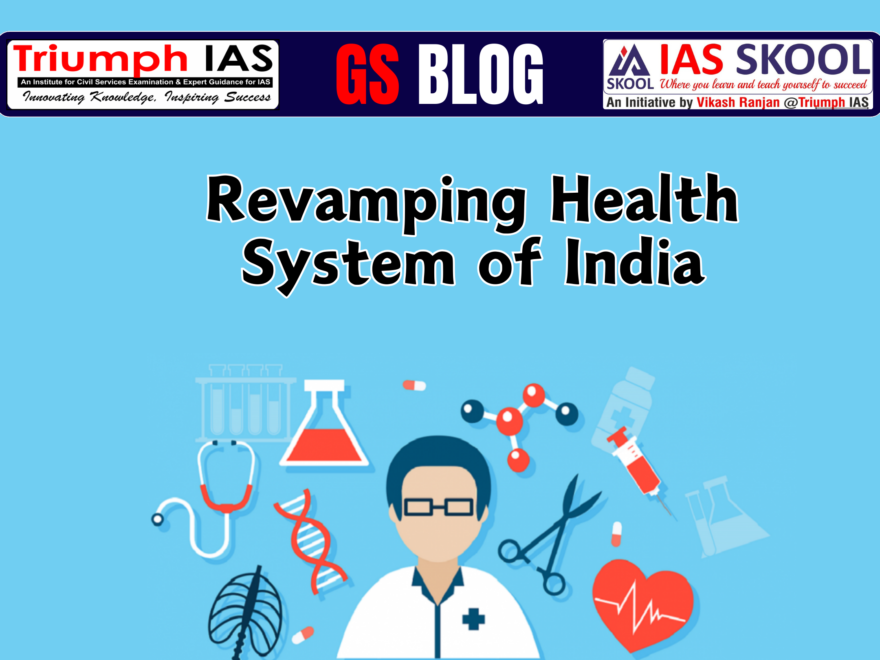Revamping Health System of India
A recent World Bank paper highlights a decline in public health spending in low- and middle-income countries, including India, reversing pre-pandemic progress. A study across 63 nations reveals that health spending growth has slowed, from 2.4% pre-pandemic to 0.9% between 2019 and 2023. In India and 34 other countries, health budgets have also decreased as a percentage of national expenditure, now at 6.5% in 2023. IMF forecasts suggest further reductions in healthcare budgets through 2029, raising concerns over the attainment of universal health coverage and Sustainable Development Goals amid growing infrastructure challenges.
Key Emerging Health Challenges that India is Facing
- Climate Change-Induced Health Crisis: Rising temperatures and extreme weather events in India are severely impacting public health, leading to alarming increases in heat-related illnesses, respiratory diseases, and vector-borne diseases. In 2022, India lost 191 billion potential labour hours due to heat exposure, a 54% rise from 1991-2000 levels. The increasing frequency of floods has also heightened the risk of waterborne diseases by contaminating water supplies, causing outbreaks of cholera, dysentery, and typhoid. Over the last three years, deaths from extreme weather events in India rose by 18%, with significant increases in vector-borne diseases like dengue.
- Antimicrobial Resistance (AMR) Crisis: India faces a severe challenge with antimicrobial resistance, exacerbated by the overuse of antibiotics, inadequate sanitation, and limited healthcare protocols. A 2022 Lancet study found that more than 47% of antibiotic formulations used in India’s private sector in 2019 lacked approval from the Central Drug Regulator, leading to widespread, often unnecessary usage. Hospitals are also seeing a rise in multi-drug-resistant infections, with reports of resistant strains of E. coli and Klebsiella pneumoniae frequently found in intensive care units (ICUs).
- Mental Health Crisis: Post-pandemic India is experiencing an unprecedented mental health crisis, with inadequate infrastructure and workforce to meet rising demand. Persistent stigma around mental health, coupled with limited access to quality care and insufficient insurance coverage, creates major barriers to treatment. The World Health Organization reported a 25% global increase in anxiety and depression due to the COVID-19 pandemic. The National Mental Health Survey estimates that 150 million Indians require mental health interventions, yet there are only 0.75 psychiatrists per 100,000 people.
- Rising Non-Communicable Diseases (NCDs): India is experiencing a rapid rise in non-communicable diseases (NCDs), including diabetes, cardiovascular diseases, and cancers, with these conditions increasingly affecting younger populations. Sedentary lifestyles, urbanization, and dietary changes are accelerating this trend. The healthcare system, historically focused on infectious disease control, now faces challenges adapting to chronic care needs. NCDs account for 63% of deaths in India and 74% worldwide. Currently, over 101 million Indians live with diabetes, up from 70 million in 2019.
- Double Burden of Diseases: India faces a “double burden of disease,” grappling with both communicable and non-communicable diseases (NCDs). Infectious diseases like tuberculosis, dengue, and malaria remain prevalent, particularly in rural and low-income areas. In the aftermath of COVID-19, India faces additional challenges from emerging and re-emerging infectious diseases, including zoonotic diseases. The country reported over 3,000 cases of H3N2 influenza in 2023 and 30 Mpox cases since the WHO’s 2022 declaration of a Public Health Emergency of International Concern (PHEIC). Simultaneously, NCDs like diabetes, hypertension, cancer, and cardiovascular diseases are on the rise due to lifestyle shifts. Annual cancer cases are expected to increase by 12.8% to reach 1.57 million by 2025. This dual challenge places significant strain on healthcare resources as systems must now manage both infectious diseases and chronic conditions requiring long-term care

Where the problem lies?
Fragmented Governance: India’s healthcare system is hindered by fragmented governance across central, state, and local levels, resulting in inconsistent policy implementation and uneven resource allocation. While states like Kerala have developed robust healthcare systems with strong health indicators, others, such as Bihar, fall behind. The Clinical Establishments Act of 2010 aims to standardize healthcare services across India; however, varying levels of state implementation have led to disparities in healthcare quality and regulation.
Inadequate Healthcare Financing: Despite ambitious initiatives, India’s public health spending remains critically low, with a high reliance on private, out-of-pocket expenses. Government health expenditure is approximately 1.9% of GDP, according to the Economic Survey 2023-24, and out-of-pocket health expenses constitute around 62.6% of total health expenditure—one of the highest in the world.
Infrastructure and Resource Disparities: A persistent urban-rural divide in healthcare infrastructure has led to significant disparities in medical facilities, equipment, and infrastructure distribution. Only 11% of sub-centers, 13% of Primary Health Centers (PHCs), and 16% of Community Health Centers (CHCs) meet Indian Public Health Standards. A Niti Aayog report highlights that roughly 65% of hospital beds cater to nearly 50% of India’s population, reflecting the uneven distribution.
Workforce Challenges and Brain Drain: The healthcare sector faces severe shortages of qualified professionals, worsened by a continuous brain drain and an uneven distribution of healthcare personnel. Although medical education capacity is expanding, quality issues persist, and graduates’ skills do not align with healthcare demands. Rural postings remain unattractive, even with incentives. The Rural Health Statistics report shows a shortfall of more than 80% in required surgeons and pediatricians across 6,064 CHCs.
Data Management and Monitoring Gaps: Despite digital initiatives, healthcare data remains poorly integrated, which impedes evidence-based policymaking and resource allocation. Real-time health surveillance is limited, affecting disease monitoring and rapid response. Privacy concerns and infrastructure gaps hinder digital health adoption; for instance, only 30% of facilities in the Health Facility Registry under the Ayushman Bharat Digital Mission are from the private sector, which controls 70% of the market.
Limited Focus on Preventive Healthcare: India’s healthcare focus largely remains on curative rather than preventive care and public health. Health education, awareness programs, and environmental health initiatives receive limited attention and resources. The government’s expenditure on preventive healthcare is only 13.55% of the Current Health Expenditure (CHE), underscoring the need for greater investment in preventive health measures.
Supply Chain and Pharmaceutical Challenges: Healthcare supply chains in India are inefficient, with frequent shortages of essential medicines and equipment. Dependence on imported active pharmaceutical ingredients (APIs) affects drug security and cost. Generic medicine programs encounter challenges related to implementation and quality perception. Approximately 70% of India’s API needs, including essential vitamins and antibiotics, are imported from China, highlighting vulnerabilities in pharmaceutical supply chains.
What measures can be adopted?
- Integrated Digital Health Ecosystem: India should accelerate the Ayushman Bharat Digital Mission by creating a unified digital health infrastructure, linking all healthcare providers from primary centers to tertiary hospitals. This ecosystem would encompass standardized Electronic Health Records (EHRs), telemedicine platforms, and real-time disease surveillance, ensuring data privacy and security. Seamless information exchange across public and private healthcare sectors is essential, especially for rural areas. Platforms like e-Sanjeevani should be expanded and strengthened, drawing on successful examples such as Tamil Nadu, which led in e-Sanjeevani OPD consultations in 2020.
- Strengthening Primary Healthcare: Health and Wellness Centers (HWCs) should serve as comprehensive primary care hubs, equipped with essential diagnostics, telemedicine, and trained staff. Emphasis should be on preventive care and early detection through regular screenings, vaccination, and community health education. Establishing a robust referral system linking primary, secondary, and tertiary care facilities will improve patient outcomes, with ASHAs and community health workers playing a vital role in community engagement. Performance-based incentives for healthcare workers can enhance service quality and retention.
- Public-Private Partnership (PPP) Reforms: New PPP models should ensure equitable access to high-quality healthcare with clear regulatory frameworks that set performance metrics, quality standards, and pricing controls. Independent monitoring systems should assess outcomes and maintain accountability. PPPs should also focus on technology transfer and capacity-building for improved healthcare infrastructure and delivery.
- Healthcare Financing Reform: India should adopt a mixed financing model, combining increased public spending with universal health insurance. Public health expenditure should gradually rise to 2.5% of GDP, supported by a dedicated health cess. Strengthening the Ayushman Bharat scheme with expanded coverage and simplified claims processes is essential. Recent extensions in health coverage under Ayushman Bharat Pradhan Mantri Jan Arogya Yojana (PMJAY) to include all senior citizens aged 70 and above mark a positive development.
- Medical Education and Workforce Development: Medical education needs modernization, with an emphasis on practical skills, digital health, and emerging technologies. Mandatory rural postings with attractive incentives and career growth should be introduced. Programs like Chhattisgarh’s Mitanin model, which employs community health workers to address doctor shortages in rural areas, offer a practical framework. Regular skill updates through a standardized continuing medical education system are also critical, and establishing medical education hubs in underserved regions would help address local health needs.
- Pharmaceutical and Medical Device Manufacturing: Strengthening domestic production of essential medicines and medical devices through Production-Linked Incentive (PLI) schemes is crucial. Establishing API parks with shared infrastructure will reduce dependence on imports. Standardizing and implementing quality controls for generic medicines will improve trust in domestic products, and expanding the Jan Aushadhi network with better supply chain management will increase access to affordable medicines.
- Emergency Preparedness System: Regional emergency response centers with sufficient surge capacity and essential supplies should be established. Real-time monitoring and early warning systems for disease outbreaks are vital. Additionally, building and maintaining strategic reserves of essential medicines and medical equipment will improve readiness for emergencies.
- Preventive Healthcare Focus: Implement comprehensive health screenings across all age groups at HWCs, integrating traditional (AYUSH) and modern medicine for a holistic approach. Workplace and school programs should target lifestyle-related diseases, while initiatives like Eat Right India and Fit India can promote healthier lifestyles.
- Modernizing Regulatory Frameworks: Establishing a unified healthcare regulatory authority with mandates for quality control and standards is essential. Implementing mandatory accreditation systems for all healthcare facilities and conducting regular audits will ensure quality. Transparent pricing for medical services and procedures should be developed to improve accessibility.
- One Health Approach: Fast-tracking the One Health approach, which integrates human, animal, and environmental health, will help prevent zoonotic disease outbreaks. Strengthened surveillance and early detection at the human-animal-environment interface are key to controlling disease spread. Collaboration between healthcare, veterinary, and environmental sectors is essential for effective implementation.
A comprehensive, multi-faceted approach is essential to tackle India’s healthcare challenges, emphasizing digital integration, preventive care, and strengthened public-private partnerships. Enhancing primary care and prioritizing preventive health can alleviate pressure on tertiary care facilities. Through well-coordinated reforms, India can effectively manage health crises and progress toward universal health coverage and the Sustainable Development Goals (SDGs).
The End of the Blog: Revamping Health System of India

|



















One comment